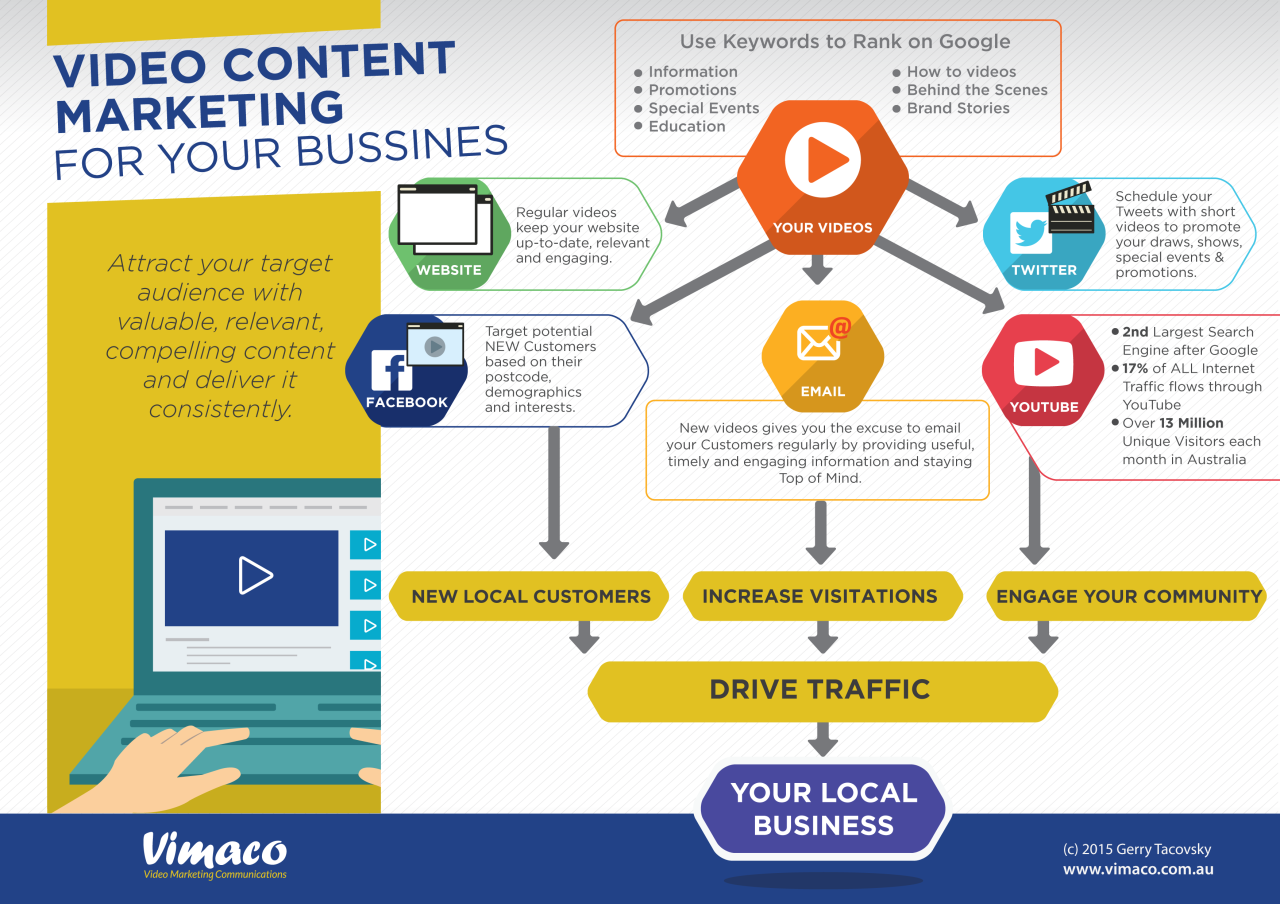
Marketing Video Content Your Visual Strategy Guide
Marketing video content is more than just pretty pictures; it’s a powerful tool for connecting with your audience and driving conversions. From captivating explainer videos to engaging product demos, this comprehensive guide will equip you with the knowledge and strategies to create and leverage video content effectively. We’ll explore everything from defining your video strategy to analyzing its performance and staying ahead of the curve with current trends.
This guide dives deep into the world of marketing video content, outlining everything from initial concept to final analysis. We’ll cover the critical steps for producing high-quality videos, including planning, production, and promotion, ensuring that your videos not only look good but also achieve your business objectives.
Defining Marketing Video Content
Marketing video content has become an indispensable tool in today’s digital landscape. It’s more than just a visual medium; it’s a powerful communication channel that can engage audiences, build brand awareness, and drive conversions. Videos offer a unique opportunity to connect with viewers on an emotional level, showcasing products or services in a dynamic and engaging way.Effective marketing videos are meticulously crafted to achieve specific business objectives.
They utilize compelling storytelling, visually appealing designs, and strategically placed calls to action to achieve measurable results. This approach helps businesses to stand out in a crowded marketplace, foster customer loyalty, and ultimately, increase profitability.
Types of Marketing Video Content
Understanding the various types of marketing videos is crucial for creating a targeted and effective strategy. Different video formats cater to specific marketing goals and audience preferences.
- Explainer videos clearly and concisely demonstrate how a product or service works. They often utilize animation, graphics, and concise narration to simplify complex ideas, making them highly effective for educating potential customers.
- Product demos showcase the practical application of a product or service, often highlighting its key features and benefits. These videos are designed to inspire confidence and encourage viewers to make a purchase. They are often used to provide a glimpse into how a product or service can be integrated into a user’s life.
- Testimonial videos feature satisfied customers sharing their positive experiences with a product or service. This social proof builds trust and credibility, convincing potential buyers that the product or service is worth their investment.
- Brand storytelling videos create an emotional connection with the audience by conveying the brand’s values, mission, and story. They often incorporate inspiring narratives, memorable visuals, and a strong sense of identity to connect on a deeper level with viewers.
- Social media videos are short-form content optimized for engagement on platforms like TikTok, Instagram, and YouTube. They utilize trending sounds, catchy visuals, and concise messaging to resonate with the platform’s audience.
Key Characteristics of Effective Marketing Video Content
Effective marketing videos possess several key characteristics that contribute to their success.
- Compelling storytelling: A strong narrative draws viewers in and keeps them engaged. It should resonate with the target audience’s values and aspirations, fostering a deeper connection.
- Clear and concise messaging: Effective videos avoid jargon and complex explanations. They present information in a simple, easily digestible format. They directly address the viewer’s needs and wants, offering value.
- High-quality visuals and audio: Professional-looking videos with crisp visuals and clear audio enhance viewer engagement and trust. Poor-quality content can quickly detract from the message and erode credibility.
- Strategic calls to action: Videos should guide viewers towards a specific desired outcome, such as visiting a website, making a purchase, or signing up for a newsletter. Calls to action are essential for driving conversions.
- Target audience focus: The content and tone of a video should be tailored to resonate with the specific audience being targeted. Understanding the audience’s needs, interests, and pain points is crucial for crafting a relevant and impactful message.
Examples of Successful Marketing Video Campaigns
Numerous successful marketing video campaigns across various industries demonstrate the power of this medium.
- Nike: Nike’s inspirational “Find Your Greatness” campaign showcases athletes overcoming challenges and achieving their goals. The emotional connection fostered by these videos has resonated with audiences worldwide.
- Red Bull: Red Bull’s extreme sports and adventurous campaigns have consistently used engaging video content to convey their brand’s energy and spirit. Their videos have become iconic, memorable, and effective in driving brand awareness.
- Dollar Shave Club: This company’s viral marketing video, with its humorous and unconventional approach, demonstrated the power of social media video in generating significant brand awareness and customer engagement.
Evolution of Marketing Video Content
Marketing video content has evolved significantly over time, adapting to technological advancements and changing audience preferences.
- Early days focused on corporate-style videos and TV commercials. These videos were often lengthy and expensive to produce.
- The rise of the internet and social media transformed video production and consumption, making it more accessible and cost-effective. This shift led to the emergence of shorter, more engaging formats.
- Today, video marketing is more personalized and interactive. Companies are leveraging user-generated content and live streaming to foster deeper connections with their audience.
Video Content Creation Strategies

Crafting compelling marketing videos is more than just pointing a camera. It’s a strategic process that involves meticulous planning, execution, and refinement. A well-executed video campaign can significantly boost brand awareness, drive engagement, and ultimately, increase conversions. This involves understanding your target audience, selecting the right format, and using the most effective tools.Effective video marketing relies on a well-defined strategy, encompassing every stage from initial concept to final delivery.
Marketing video content is crucial for grabbing attention, but how do you keep that engagement going? Using Instagram Stories Highlights, you can showcase your best video content in a highly organized and accessible way, making it easy for your followers to quickly find what they’re looking for. Check out this helpful guide on how to use Instagram Stories Highlights to wow your followers here for some great tips and tricks.
This will ultimately boost your video marketing efforts by driving more engagement and brand awareness.
This detailed approach ensures that your video resonates with your target audience and achieves your desired objectives.
Pre-Production
This crucial phase sets the foundation for a successful video. It’s the stage where you lay out the blueprint for your video. Thorough planning ensures your video aligns with your marketing goals and resonates with your target audience. Key aspects of pre-production include comprehensive audience research, meticulous scriptwriting, and meticulous budgeting.
- Audience Research: Understanding your target audience is paramount. This involves identifying their demographics, interests, pain points, and online behavior. Analyzing existing data from social media, surveys, and market research provides valuable insights into what resonates with your target audience, guiding your content creation process.
- Scriptwriting: A compelling script is the backbone of any successful video. It needs to be concise, engaging, and aligned with your brand’s voice and message. A well-written script will help keep your video on track and ensure your message is clear.
- Budgeting: Establishing a realistic budget is essential to avoid unforeseen financial hurdles. This involves calculating the costs associated with equipment, crew, location, and post-production. A detailed budget helps maintain financial control and ensures you stay within your allocated resources.
- Location Scouting: The right location can significantly enhance the visual appeal of your video. Scouting locations that align with your brand and message is crucial to achieving your desired visual aesthetic. This process involves considering factors like lighting, space, and overall ambiance.
Production
The production phase brings your vision to life. This stage involves capturing high-quality footage and ensuring a seamless flow. Coordination and clear communication between team members are crucial to maintain the desired quality and tempo.
- Filming: This stage requires precise execution of the pre-production plan. Effective communication and collaboration between the director, crew, and talent are essential for capturing high-quality footage. This process requires attention to detail and adherence to the planned schedule.
- Talent Management: Choosing the right talent is crucial. This involves selecting individuals who can effectively deliver your message and maintain a consistent brand image. This aspect encompasses casting calls, rehearsals, and on-set support.
Post-Production
Post-production is where the raw footage is transformed into a polished final product. This stage involves meticulous editing, sound design, and color grading. High-quality editing ensures a seamless and engaging viewing experience.
- Video Editing: Video editing software tools allow for trimming, adding transitions, and enhancing visual elements. Popular choices include Adobe Premiere Pro, Final Cut Pro, and DaVinci Resolve. Selecting the appropriate software depends on your specific needs and budget.
- Sound Design: Sound design is crucial for creating an immersive viewing experience. This involves adjusting audio levels, adding background music, and incorporating sound effects. The goal is to create a balanced and engaging auditory environment.
- Color Grading: Color grading enhances the visual appeal of your video by adjusting color tones and saturation. This step is crucial for creating a consistent brand identity and maintaining visual appeal.
Video Content Formats
Understanding video content formats is key to reaching your target audience effectively.
- Short-Form Videos: Short-form videos, like TikTok or Instagram Reels, are ideal for grabbing attention quickly. These videos typically have a shorter duration, requiring concise messaging and engaging visuals.
- Long-Form Videos: Long-form videos, such as explainer videos or product demos, provide more in-depth information. These videos often have a longer duration, allowing for detailed explanations and demonstrations.
Video Editing Software
Different video editing software tools cater to various needs and budgets.
| Software | Pros | Cons |
|---|---|---|
| Adobe Premiere Pro | Industry-standard, versatile features | Steep learning curve, expensive |
| Final Cut Pro | Excellent for Mac users, intuitive interface | Limited cross-platform compatibility |
| DaVinci Resolve | Powerful editing tools, free version available | Steeper learning curve than others |
Video Content Calendar
Planning a video content calendar ensures a consistent output schedule.
- Establish Goals: Define specific objectives for your video content, such as increasing brand awareness or driving sales.
- Identify Target Audience: Understand your target audience’s preferences and needs to tailor your content.
- Content Calendar Template: Create a spreadsheet or document to Artikel your video topics, dates, and deadlines.
Storyboard Example
A storyboard Artikels the key scenes of a promotional video.
A promotional video for a new fitness app might include the following scenes:
- Scene 1: Person struggling with a workout routine
- Scene 2: Person using the app to plan their workout
- Scene 3: Person enjoying a successful workout
- Scene 4: Person sharing positive feedback about the app
Content Production Techniques: Marketing Video Content
Crafting compelling marketing videos requires a blend of strategic scripting, engaging visuals, and a clear understanding of audio dynamics. The key is to weave a narrative that resonates with the target audience, encourages action, and ultimately drives conversions. A well-produced video can significantly impact brand perception and build trust, especially in today’s visually-driven world.Producing effective marketing videos transcends simply capturing footage; it involves careful planning and execution across various stages.
From scripting to editing, each step plays a crucial role in achieving the desired outcome. This section delves into the specifics of these production techniques, equipping you with the knowledge to create impactful video content.
Key Elements of a Compelling Video Script
A strong video script is the foundation of a successful marketing video. It should be concise, engaging, and tailored to the specific objectives. Clear articulation of the message, use of storytelling techniques, and concise language are crucial for maximizing viewer understanding and retention. The script should be easy to follow and maintain viewer interest, guiding them through the narrative seamlessly.
- Strong Opening Hook: A captivating opening is essential to immediately grab the viewer’s attention. This could be a compelling question, a surprising statistic, or a powerful image. For example, a video promoting a new fitness app could open with a dramatic before-and-after transformation. This hook should be directly related to the product or service being promoted.
- Compelling Narrative: The script should tell a story that resonates with the target audience. Whether it’s a testimonial, a problem-solution narrative, or a journey, the story should connect emotionally with viewers.
- Clear and Concise Messaging: The script must clearly communicate the key message of the video. Avoid jargon and overly technical language. Instead, use straightforward language that everyone can understand.
- Call-to-Action (CTA): The script should include a clear and concise call-to-action. This could be a link to a website, a social media handle, or a phone number.
Role of Visuals and Audio in Marketing Videos
Visuals and audio are integral to creating a compelling viewing experience. They work in tandem to enhance the narrative and reinforce the message. High-quality visuals and crisp audio contribute to a professional and engaging video, whereas poor quality can undermine the impact of the content.
- Visual Appeal: High-quality visuals are crucial for capturing attention and creating a lasting impression. Consider using professional-grade cameras and lighting to ensure a polished look.
- Audio Quality: Clear audio is just as important as high-quality visuals. Use high-quality microphones to capture clear dialogue and music, ensuring the audio complements the visuals and enhances the viewer’s experience.
Effective Video Storytelling Techniques
Effective storytelling techniques are crucial for creating engaging marketing videos. They help viewers connect with the brand and product on an emotional level. Consider using different techniques, such as character development, conflict resolution, and emotional appeals.
- Show, Don’t Tell: Use visuals to illustrate your points, rather than simply stating them. For instance, instead of saying “Our product is user-friendly,” show a user effortlessly navigating the interface.
- Use of Characters: Develop relatable characters who face challenges and overcome them using the product or service. This approach builds empathy and connection with the audience.
- Create a Sense of Urgency: Use limited-time offers, scarcity, or exclusive previews to motivate viewers to take action. This creates a sense of immediacy and encourages engagement.
Video Quality and Resolution
The quality and resolution of your video are directly related to the overall impact. The quality should be appropriate for the platform and target audience. High-resolution videos provide a superior viewing experience, while lower resolutions might be suitable for mobile viewing.
| Resolution | Platform | Purpose |
|---|---|---|
| 4K | Streaming platforms, large screens | High-quality visuals, cinematic feel |
| HD | YouTube, social media | Clear visuals, suitable for most platforms |
| SD | Mobile devices | Accessibility, smaller file sizes |
Video Editing Software for Enhancing Content
Video editing software can significantly enhance your marketing videos. It allows you to refine footage, add transitions, and apply effects to create a polished and professional-looking video. The choice of software depends on your budget and technical expertise.
- Adobe Premiere Pro: A powerful professional-grade editor with a vast array of features.
- Final Cut Pro: A powerful and intuitive editor commonly used by professionals.
- DaVinci Resolve: A free and powerful non-linear video editor with advanced features.
Importance of Effective Call-to-Actions
A strong call-to-action (CTA) is essential for driving conversions. It should be clear, concise, and visually prominent within the video. A well-placed CTA encourages viewers to take the desired action, such as visiting a website, subscribing to a newsletter, or making a purchase.
Video Content Distribution and Promotion
Distributing your marketing videos effectively is crucial for reaching your target audience and maximizing their impact. This involves more than just uploading a video; it’s a strategic process that requires understanding the nuances of different platforms and tailoring your approach to each. Successful distribution hinges on optimizing for visibility, engagement, and ultimately, conversions.Video distribution is not a one-size-fits-all approach.
Marketing video content is booming, and for good reason. It’s a fantastic way to engage audiences and boost brand awareness. However, optimizing this content for search engines is crucial. Understanding how Search Generative Experience (SGE) impacts SEO is key to maximizing your video’s visibility how does sge affect seo. Ultimately, creating compelling and well-structured video content that caters to both viewers and search engines is the winning formula.
Understanding the specific characteristics of various platforms and adapting your strategy accordingly is key to success. Knowing where your target audience spends their time online, and then tailoring your video content to resonate with them, is paramount.
Video Distribution Platforms
Different platforms offer distinct strengths and weaknesses for video distribution. A multifaceted approach, utilizing various channels, will broaden your reach and potentially increase engagement. Knowing where your target demographic congregates online is key to choosing the right distribution channels.
- Social Media: Platforms like YouTube, Facebook, Instagram, and TikTok provide powerful avenues for video promotion. Each platform has its own unique algorithm, influencing visibility. Understanding these algorithms is essential for optimizing your video’s performance.
- Websites: Embedding videos directly on your website allows for seamless integration into the user experience. This method enables direct engagement and offers a way to present in-depth content.
- Email Marketing: Email remains a highly effective channel for sharing videos with your subscriber base. Videos in emails can enhance engagement and encourage interaction. Integrating a concise call to action (CTA) within your emails is recommended to improve response rates.
Optimizing Videos for Different Platforms
Tailoring your videos for different platforms is essential for maximizing their impact. Understanding the visual and textual characteristics preferred by each platform ensures your video is seen and appreciated by the intended audience.
- Social Media: Consider the platform’s typical video length and format preferences. Optimize video titles and descriptions for searchability. Use relevant hashtags to increase discoverability. Include eye-catching thumbnails.
- Websites: Ensure videos are optimized for playback on different devices. Use descriptive video titles and transcripts or closed captions. Ensure your website’s loading speed is optimized to avoid delays.
- Email Marketing: Keep videos concise and impactful. Include a compelling subject line. Provide clear call-to-action buttons within the email.
Importance of Video Engagement Metrics
Tracking video engagement metrics provides valuable insights into how your audience interacts with your content. These metrics offer data-driven decisions for future content creation and strategies.
- Views: A straightforward metric indicating the reach of your video. High view counts are important but not the only indicator of success.
- Likes, Shares, and Comments: These metrics indicate audience interest and engagement. Analyze what types of content are generating the most interaction to further improve strategies.
- Click-Through Rates (CTR): A key metric to assess the effectiveness of calls-to-action (CTAs) within your videos.
Importance of A/B Testing Video Content
A/B testing different video variations allows you to identify what resonates most with your target audience. This systematic testing allows you to refine your content and improve its effectiveness.
- Experiment with different video formats (e.g., shorter, longer, animated, live).
- Vary titles and descriptions to see which resonate best.
- Change call-to-action (CTA) elements to gauge their effectiveness.
Simple Video Promotion Campaign Structure
A structured video promotion campaign helps maintain consistency and achieve specific goals. A well-defined campaign plan with clear objectives and a timeline is recommended.
| Phase | Activities |
|---|---|
| Planning | Define target audience, objectives, budget, and timeline. |
| Creation | Develop engaging video content and optimize it for different platforms. |
| Distribution | Share videos across chosen platforms, employing targeted strategies. |
| Tracking | Monitor engagement metrics, analyze results, and make adjustments as needed. |
Social Media Marketing Tactics for Video Promotion
Utilizing social media effectively is crucial for promoting your videos. Understanding the best practices on each platform is key to maximizing visibility and engagement.
- Targeted advertising on relevant social media platforms.
- Collaborations with influencers who resonate with your target audience.
- Contests and giveaways to encourage engagement.
- Engaging in conversations with your audience through comments and direct messages.
- Utilizing relevant hashtags to increase discoverability.
Analyzing Video Content Performance
Understanding how your videos perform is crucial for optimizing your marketing strategy. Analyzing video performance metrics allows you to identify what resonates with your audience, refine your content creation process, and ultimately drive better results. This data-driven approach helps you understand what’s working, what’s not, and how to make future videos even more effective.
Tracking Video Performance Metrics
A robust framework for tracking video performance metrics is essential for evaluating the success of your campaigns. This involves monitoring key performance indicators (KPIs) across various stages, from initial viewership to long-term engagement. Consistent monitoring allows for the identification of trends and patterns, enabling informed decisions for future video production and distribution.
Key Metrics for Evaluating Video Success
Several key metrics provide insights into the effectiveness of your videos. These metrics include views, watch time, click-through rates, audience retention, and social media engagement. Each metric offers a different perspective on how well your videos perform and can help identify areas for improvement.
Marketing video content is a fantastic way to engage audiences and boost brand awareness. However, the effectiveness of these videos, just like any other marketing strategy, can be impacted by a company’s size. Understanding how factors like budget, resources, and the overall SEO strategy, as detailed in this helpful guide on does company size affect seo strategy , plays a role in your video marketing campaign is key.
Ultimately, well-produced and strategically placed videos remain a powerful tool for any company, regardless of its size.
Measuring Audience Engagement with Videos
Audience engagement is a critical component of video success. It goes beyond simple views and delves into how actively your audience interacts with the content. Metrics such as likes, comments, shares, and subscriptions indicate how compelling and relevant your videos are to your target audience. Analyzing these metrics helps tailor future video content to maintain and increase engagement.
Methods for Analyzing Video Analytics, Marketing video content
Analyzing video analytics involves a systematic approach to interpreting data from various platforms. Tools like YouTube Analytics, Vimeo Analytics, and social media analytics dashboards provide comprehensive data on video performance. This data can be segmented by demographics, geographic location, and viewer behavior.
Video Analytics Tools Comparison
Different video analytics tools offer varying levels of detail and features. Comparing and contrasting these tools is essential to selecting the best fit for your needs. Consider factors such as ease of use, the range of data collected, and the ability to integrate with other marketing tools. For instance, a tool that integrates with your CRM system can provide a more holistic view of how your videos are affecting overall customer engagement.
Structuring Video Metrics
A structured approach to tracking video metrics facilitates data interpretation and analysis. This table presents a framework for categorizing and monitoring key performance indicators:
| Metric | Description | Importance |
|---|---|---|
| Views | Total number of times the video was viewed. | Fundamental metric to gauge initial reach. |
| Watch Time | Average duration viewers spend watching the video. | Indicates viewer engagement and content relevance. |
| Click-Through Rate (CTR) | Percentage of viewers who clicked on a link or call to action within the video. | Crucial for measuring conversion rates and campaign effectiveness. |
| Audience Retention | Percentage of viewers who watched a specific portion of the video. | Shows how well the video holds the audience’s attention throughout. |
| Social Shares | Number of times the video was shared on social media platforms. | Reflects the video’s virality and social impact. |
| Likes/Dislikes | Number of likes and dislikes received. | Shows audience sentiment towards the video content. |
Video Content Trends
The marketing landscape is constantly evolving, and video content is no exception. Understanding the emerging trends, the impact of technology, and the role of AI is crucial for staying ahead of the curve and creating engaging video campaigns. This exploration dives into the dynamic world of video marketing, examining the future and innovative approaches.The digital age has democratized video creation, empowering businesses of all sizes to produce compelling content.
Simultaneously, viewer expectations have risen, demanding high-quality visuals, engaging narratives, and seamless integration across platforms. This shift necessitates a proactive approach to video content creation, requiring marketers to adapt to the ever-changing technological advancements.
Emerging Trends in Marketing Video Content
Video content trends are driven by viewer preferences, technological advancements, and the need for greater efficiency in content production. Short-form video continues to dominate, with platforms like TikTok and Instagram Reels pushing the boundaries of concise storytelling. Interactive elements, such as polls, quizzes, and Q&A sessions, are becoming increasingly popular, enhancing viewer engagement and fostering a sense of community.
Personalized video experiences, tailored to individual viewer preferences, are also gaining traction, leading to higher viewer retention and conversion rates.
Impact of Technology on Marketing Video Content
Technological advancements have significantly impacted video marketing. High-speed internet access has made streaming video more accessible and convenient. The proliferation of smartphones and mobile devices has also made video consumption highly portable, with users engaging with content anytime, anywhere. Furthermore, advancements in video editing software and AI tools have lowered the barrier to entry for creating professional-quality videos, allowing businesses to produce high-impact content with limited resources.
Use of Artificial Intelligence in Video Creation
AI is revolutionizing video creation by automating tasks such as video editing, scriptwriting, and even generating realistic video content. AI-powered tools can analyze viewer data to tailor video content to specific demographics and preferences, optimizing engagement and conversion rates. AI can also assist with video optimization for different platforms and devices. For instance, tools can automatically generate subtitles and captions, making videos more accessible to a wider audience.
Further, AI is also enhancing video production through realistic video generation and other creative enhancements.
Future of Marketing Video Content
The future of video marketing lies in leveraging the power of emerging technologies, personalization, and interactivity. Virtual reality (VR) and augmented reality (AR) are expected to play an increasingly important role, offering immersive experiences and enhancing viewer engagement. The integration of AI-powered tools will further streamline video production, optimization, and analysis, allowing businesses to create more targeted and effective video campaigns.
Ultimately, the future of video marketing will be characterized by seamless user experiences, personalized content, and a greater emphasis on storytelling.
Innovative Marketing Video Approaches
Several innovative marketing video approaches are gaining popularity, demonstrating the versatility and impact of video marketing. One approach is the use of animated explainer videos, which can effectively communicate complex information in an engaging and easily digestible format. Another is leveraging user-generated content (UGC) to showcase real-world applications of products or services, building trust and credibility among viewers.
Furthermore, the integration of video into social commerce platforms, enabling direct purchasing within the video, is emerging as a potent trend.
Insights on Impact of Trends on Future Strategies
These trends will fundamentally reshape future marketing strategies. Marketers need to adapt to short-form video consumption, create interactive experiences, and personalize video content to resonate with individual viewers. Moreover, embracing AI-powered tools for video creation, optimization, and analysis will be critical for maintaining competitiveness. Businesses should also explore the potential of VR/AR and social commerce integrations to create immersive and engaging video experiences.
Examples of Video Content
Marketing videos are a powerful tool for connecting with audiences and driving conversions. They offer a unique opportunity to showcase products, build brand trust, and tell compelling stories. Choosing the right video format and strategy is crucial for maximizing impact. Different video types cater to diverse needs and target audiences, from engaging product demonstrations to building trust through testimonials.
Video Content Examples by Industry/Product Category
This section provides diverse examples of marketing videos, categorized by industry or product category, highlighting their strengths and weaknesses, and their role in overall marketing strategy.
| Industry/Product Category | Video Type | Video Example Description | Strengths | Weaknesses | Marketing Strategy Fit |
|---|---|---|---|---|---|
| Beauty | Product Demo | A video showcasing a new foundation, highlighting its coverage, texture, and application. The video demonstrates the product’s versatility with different lighting and skin tones. Professional makeup artists are featured. | Visually appealing, provides a hands-on experience, showcases product benefits, builds trust through credibility. | Requires a skilled makeup artist, potentially expensive to produce, may need additional visuals (e.g., before and after comparisons). | Directly demonstrates product features and benefits, targets specific customer needs (e.g., skin type, concern), aligns with online beauty communities, enhances user engagement. |
| Technology | Behind-the-Scenes | A glimpse into the development process of a new smartphone. The video showcases the engineers, designers, and researchers involved, highlighting the innovation and dedication behind the product. | Builds brand trust, humanizes the brand, creates a sense of community, showcases company culture, positions the company as innovative. | May not directly demonstrate product functionality, can be perceived as too lengthy or generic, requires careful content curation to avoid sounding self-serving. | Attracts tech-savvy consumers, emphasizes brand values and company culture, creates a sense of anticipation for product releases, positions the company as industry leaders. |
| Food | Testimonial | A video featuring satisfied customers sharing their positive experiences with a new line of gourmet coffee. The testimonials focus on the taste, aroma, and overall satisfaction of the product. | Builds credibility, increases social proof, creates an emotional connection with customers, positions the product as high-quality and enjoyable. | Can be vulnerable to inconsistencies in the testimonials, requires meticulous selection of authentic testimonials, can be expensive if celebrities are involved. | Targets specific consumer desires (e.g., quality, taste, experience), emphasizes positive feedback, leverages social proof, reinforces brand reputation. |
| Fashion | Style Guide | A video tutorial demonstrating how to style a specific clothing item (e.g., a blazer) for different occasions. The video features various outfit combinations and accessories. | Provides valuable information, inspires creativity, positions the brand as a style authority, increases brand awareness, enhances customer engagement. | Requires a skilled stylist, can be time-consuming to produce, may not appeal to all customer segments, requires ongoing content creation to maintain relevance. | Targets fashion-conscious customers, demonstrates product versatility, enhances product knowledge, creates engagement and community. |
Video Content Formats
Understanding various video formats is essential for crafting effective marketing campaigns.
| Format | Description | Strengths | Weaknesses |
|---|---|---|---|
| Product Demo | Showcases product features and benefits through demonstrations. | Directly demonstrates value, builds trust, provides visual engagement. | Can be overly technical, may require significant production effort. |
| Testimonial | Emphasizes positive feedback from satisfied customers. | Builds credibility, increases social proof, creates emotional connection. | Requires carefully selected testimonials, can be vulnerable to inconsistencies. |
| Behind-the-Scenes | Provides a look at the production process or company culture. | Humanizes the brand, builds trust, enhances brand image. | May not directly demonstrate product functionality. |
| Explainer | Clarifies complex topics or processes using animation or visuals. | Simplifies information, increases comprehension, engaging for viewers. | Can be expensive to produce, requires skilled animators. |
Production Process Example: Product Demo
A detailed breakdown of the production process for a product demo video focuses on planning, pre-production, production, and post-production stages. Each stage is crucial for ensuring a high-quality video that effectively communicates the product’s value proposition.
- Planning: Defining the target audience, outlining the key product features to be highlighted, and establishing the desired tone and style of the video. A clear script outlining the demonstration process and key talking points is essential.
- Pre-Production: Gathering necessary equipment (e.g., camera, lighting, microphone), scouting suitable locations, and finalizing the script. Creating a detailed shot list and storyboard is crucial to maintain consistency and clarity.
- Production: Filming the product demo according to the storyboard. Maintaining a consistent style and quality throughout the recording is important. Capturing high-quality video and audio is essential.
- Post-Production: Editing the footage, adding music and sound effects, and creating graphics to enhance the visual appeal. Ensuring the video’s overall tone and message align with the brand is critical.
Ending Remarks

In conclusion, crafting effective marketing video content is a multi-faceted process requiring careful planning, engaging storytelling, and a deep understanding of your target audience. By following the steps Artikeld in this guide, you can develop a comprehensive video strategy that enhances brand awareness, drives conversions, and ultimately achieves your business goals. So, get ready to unlock the power of visual storytelling and transform your marketing efforts with compelling video content.





